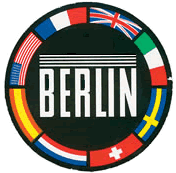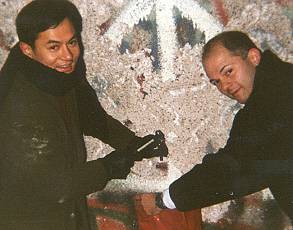![Mainzer Domplatz [Domplatz zu Mainz]](graphics/mzdompltz.jpg)
Easter 1992 letter, continued
![Mainzer Domplatz [Domplatz zu Mainz]](graphics/mzdompltz.jpg)
![]() Golden Mainz, like Durham in England, was an historically important see ruled by a prince-bishop. The palatinate (Pfalz) is symbolized heraldically in the coats of arms for both sees by incorporating sword, crown and crosier to denote both temporal and spiritual authority of the incumbent. The prince bishop of Mainz was also a Kurfürst, or Elector, of the Holy Roman Empire. The massive Romanesque cathedral dominates the Rhein. Like other imperial cathedrals, Mainz is built with an apse at each end -- that at the west for the Kaiser and his court.
Golden Mainz, like Durham in England, was an historically important see ruled by a prince-bishop. The palatinate (Pfalz) is symbolized heraldically in the coats of arms for both sees by incorporating sword, crown and crosier to denote both temporal and spiritual authority of the incumbent. The prince bishop of Mainz was also a Kurfürst, or Elector, of the Holy Roman Empire. The massive Romanesque cathedral dominates the Rhein. Like other imperial cathedrals, Mainz is built with an apse at each end -- that at the west for the Kaiser and his court.
![]()
For a year Karl-Heinz and I lived with the missionary Oblates of Mary Immaculate at their Bonifatius Oblatenkloster auf dem Hartenberg near Mainz University. At the local parish fair I bought a green Hercules bicycle for only 70,-- DM which served me well for the next three years. ![HMML Microfilm Camera [Microfilm Camera]](graphics/mfcamera.jpg)
We filmed at the city library (Stadtbibliothek), final home for a large collection of books from the Carthusian monastery of Saint Michael -- a very strict monastery of hermits located on a hill near the edge of the city, but long since abandoned and destroyed. Other collections came from Carmelite, Benedictine, Jesuit, Capuchin, and Augustinian houses. We also filmed the small number of manuscripts from the present university library and those on permanent exhibit at the Gutenberg Museum, a showplace for the history of writing and printing.
![Double Wheel symbol of
Mainz [City Flags]](graphics/mainzflags.jpg) Preparing the descriptions of the manuscripts at Mainz was the most challenging work I did since I had to compare almost every manuscript with the brief Latin descriptions in a hand-written mid-nineteenth century catalog. At most other locations printed contemporary catalogs were available.
Preparing the descriptions of the manuscripts at Mainz was the most challenging work I did since I had to compare almost every manuscript with the brief Latin descriptions in a hand-written mid-nineteenth century catalog. At most other locations printed contemporary catalogs were available.
While living in Mainz I fell in with a fine group of American officers and service personnel stationed in Wiesbaden or Frankfurt. The Bonifatiuskloster was only a block away from the Martin Luther King Village Housing Area, a somewhat unlovely feature of the neighborhood that had once been garden plots for the citizens of Mainz. None of the GI's I got to know, however, lived so close. Sharing travel expenses, we investigated historical German and European sites on occasional excursions.
![]() It was a joy to be back in England for one
It was a joy to be back in England for one![[Rule, Britannia!]](graphics/raj8906.jpg) of the sunniest Junes ever. What a great way it was to celebrate the heat in the fun and costumes of a Raj Party with my pals from Durham, rousing tunes and plenty of Pimms Cup Nr. 1.
of the sunniest Junes ever. What a great way it was to celebrate the heat in the fun and costumes of a Raj Party with my pals from Durham, rousing tunes and plenty of Pimms Cup Nr. 1.
My task in Britain was to oversee the completion of the filming at Saint Hugh's Charterhouse, Parkminster, near Brighton, and Syon Abbey (Briggitine) in Devon. ![[Jane and Michael Gunn at Parkminster] [Jane and Michael Gunn]](graphics/gunns.jpg) The filming was executed by Academic Microforms, the firm with whom I had worked in 1984-85 filming the stunning collection of manuscripts at Durham Cathedral and University. Jane and Michael Gunn (at left) spend much of their time at the other end of the kingdom in Wick, Scotland, where they manage the Clan Gunn Museum.
The filming was executed by Academic Microforms, the firm with whom I had worked in 1984-85 filming the stunning collection of manuscripts at Durham Cathedral and University. Jane and Michael Gunn (at left) spend much of their time at the other end of the kingdom in Wick, Scotland, where they manage the Clan Gunn Museum.
I recently learned that plans are underway to deposit the copies of the Parkminster films at the Bodleian Library -- thereby protecting the peace and solitude of the hermit-monks from being disturbed by requests for information or copies. I attended the annual meeting of the Friends of the Bodleian Library on 20 June and next day witnessed the Encaenia Procession -- one of the most colorful academic occasions in the world.
At the end of October, shortly after Hungary declared itself a republic, I became seriously ill with the initial phase of rheumatoid arthritis. My knees, wrists and ankles became terribly inflamed, and I could barely walk. Eventually I received relief with a few shots of Cortisone and regular doses of Ibuprofen. I was happy that injections of gold into my wrists would not be necessary. In November Karl-Heinz and I moved the filming project to Frankfurt.
![]()
![[Relics of Saint La Salle, Rome] [La Sallian Reliquary]](graphics/rom8912va.jpg) I spent Christmas 1989 in Rome where my brother, Br. Benedict FSC, worked with an international team of De La Salle Christian Brothers on their new "Directory of Formation." We made reciprocal visits to each other's Roman headquarters -- his on the Via Aurelia and mine atop the Aventine Hill near the circus maximus. While at my brother's place on Christmas Day we were kept informed about the 1989 Invasion of Panama through telefax updates sent from the community there to a Panamanian Brother also working on the Directory. 29 December I flew from Rome to Berlin.
I spent Christmas 1989 in Rome where my brother, Br. Benedict FSC, worked with an international team of De La Salle Christian Brothers on their new "Directory of Formation." We made reciprocal visits to each other's Roman headquarters -- his on the Via Aurelia and mine atop the Aventine Hill near the circus maximus. While at my brother's place on Christmas Day we were kept informed about the 1989 Invasion of Panama through telefax updates sent from the community there to a Panamanian Brother also working on the Directory. 29 December I flew from Rome to Berlin.
 I was fortunate to have been in Europe during a period of such momentous and historic change. With a group of about 10 American and German friends, I celebrated Silvester (New Year's Eve) 1989 in Berlin. We enjoyed a festive dinner at the Hotel Mondiale on the Ku'dam. The menu was limited to the traditional fare for the last evening of the year: venison or carp (Bambi or Goldie). At midnight we dodged fireworks at the highly recognizable Kaiser Wilhelm Gedächtnis-Kirche near Bahnhof Zoo.
I was fortunate to have been in Europe during a period of such momentous and historic change. With a group of about 10 American and German friends, I celebrated Silvester (New Year's Eve) 1989 in Berlin. We enjoyed a festive dinner at the Hotel Mondiale on the Ku'dam. The menu was limited to the traditional fare for the last evening of the year: venison or carp (Bambi or Goldie). At midnight we dodged fireworks at the highly recognizable Kaiser Wilhelm Gedächtnis-Kirche near Bahnhof Zoo.

![]() Windy, bitter cold did not daunt the cheery thousands who chiseled away at some of the first holes to be made in the Berlin Wall. Only days before, the Brandenburg Gate had been opened allowing access to both sides of the city for German citizens. Berliners waited patiently in line for the long-denied chance to stroll once again Unter den Linden. Americans, however, including our military, had to enter via Checkpoint Charlie. I returned to Frankfurt am Main with a small collection of the obligatory relics of Wall fragments. The density of the concrete made sledge hammers the recommended tool. Some arrived with household tools that made barely a dent in the tough excavation to freedom.
Windy, bitter cold did not daunt the cheery thousands who chiseled away at some of the first holes to be made in the Berlin Wall. Only days before, the Brandenburg Gate had been opened allowing access to both sides of the city for German citizens. Berliners waited patiently in line for the long-denied chance to stroll once again Unter den Linden. Americans, however, including our military, had to enter via Checkpoint Charlie. I returned to Frankfurt am Main with a small collection of the obligatory relics of Wall fragments. The density of the concrete made sledge hammers the recommended tool. Some arrived with household tools that made barely a dent in the tough excavation to freedom.
1987 * 1988 * 1989 * 1990 * 1991-92